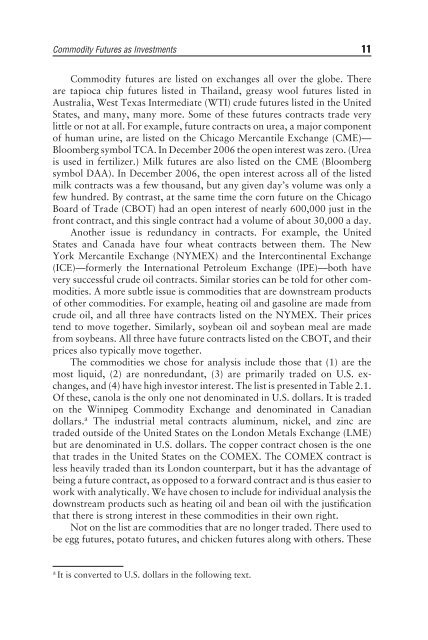Maximizing Returns through Fundamental Analysis - Arabictrader.com
Maximizing Returns through Fundamental Analysis - Arabictrader.com
Maximizing Returns through Fundamental Analysis - Arabictrader.com
You also want an ePaper? Increase the reach of your titles
YUMPU automatically turns print PDFs into web optimized ePapers that Google loves.
Commodity Futures as Investments 11<br />
Commodity futures are listed on exchanges all over the globe. There<br />
are tapioca chip futures listed in Thailand, greasy wool futures listed in<br />
Australia, West Texas Intermediate (WTI) crude futures listed in the United<br />
States, and many, many more. Some of these futures contracts trade very<br />
little or not at all. For example, future contracts on urea, a major <strong>com</strong>ponent<br />
of human urine, are listed on the Chicago Mercantile Exchange (CME)—<br />
Bloomberg symbol TCA. In December 2006 the open interest was zero. (Urea<br />
is used in fertilizer.) Milk futures are also listed on the CME (Bloomberg<br />
symbol DAA). In December 2006, the open interest across all of the listed<br />
milk contracts was a few thousand, but any given day’s volume was only a<br />
few hundred. By contrast, at the same time the corn future on the Chicago<br />
Board of Trade (CBOT) had an open interest of nearly 600,000 just in the<br />
front contract, and this single contract had a volume of about 30,000 a day.<br />
Another issue is redundancy in contracts. For example, the United<br />
States and Canada have four wheat contracts between them. The New<br />
York Mercantile Exchange (NYMEX) and the Intercontinental Exchange<br />
(ICE)—formerly the International Petroleum Exchange (IPE)—both have<br />
very successful crude oil contracts. Similar stories can be told for other <strong>com</strong>modities.<br />
A more subtle issue is <strong>com</strong>modities that are downstream products<br />
of other <strong>com</strong>modities. For example, heating oil and gasoline are made from<br />
crude oil, and all three have contracts listed on the NYMEX. Their prices<br />
tend to move together. Similarly, soybean oil and soybean meal are made<br />
from soybeans. All three have future contracts listed on the CBOT, and their<br />
prices also typically move together.<br />
The <strong>com</strong>modities we chose for analysis include those that (1) are the<br />
most liquid, (2) are nonredundant, (3) are primarily traded on U.S. exchanges,<br />
and (4) have high investor interest. The list is presented in Table 2.1.<br />
Of these, canola is the only one not denominated in U.S. dollars. It is traded<br />
on the Winnipeg Commodity Exchange and denominated in Canadian<br />
dollars. a The industrial metal contracts aluminum, nickel, and zinc are<br />
traded outside of the United States on the London Metals Exchange (LME)<br />
but are denominated in U.S. dollars. The copper contract chosen is the one<br />
that trades in the United States on the COMEX. The COMEX contract is<br />
less heavily traded than its London counterpart, but it has the advantage of<br />
being a future contract, as opposed to a forward contract and is thus easier to<br />
work with analytically. We have chosen to include for individual analysis the<br />
downstream products such as heating oil and bean oil with the justification<br />
that there is strong interest in these <strong>com</strong>modities in their own right.<br />
Not on the list are <strong>com</strong>modities that are no longer traded. There used to<br />
be egg futures, potato futures, and chicken futures along with others. These<br />
a It is converted to U.S. dollars in the following text.










